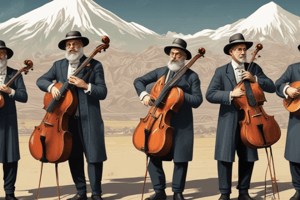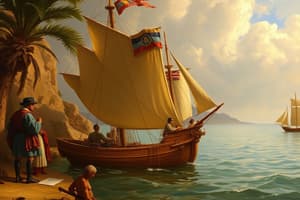Podcast
Questions and Answers
What is the defining characteristic of a folk tale?
What is the defining characteristic of a folk tale?
- It is created by known single authors.
- It includes miraculous transformations for protagonists.
- It features fairy characters prominently.
- It has been collected from oral sources and transcribed into print. (correct)
How is a wonder tale typically defined?
How is a wonder tale typically defined?
- As a tale featuring realistic events.
- As a tale without any magical elements.
- As a tale with miraculous transformations aiding protagonists. (correct)
- As a tale written by literate classes.
What distinguishes a fairy tale from a wonder tale?
What distinguishes a fairy tale from a wonder tale?
- Fairy tales have literary origins and are written by known authors. (correct)
- Fairy tales focus on realistic events.
- Wonder tales are written by known single authors.
- Fairy tales never include elements of magic.
What term is used in German to distinguish artistic tales?
What term is used in German to distinguish artistic tales?
Folk tales were mainly told and retold by which group of individuals?
Folk tales were mainly told and retold by which group of individuals?
Fairy tales as a term first appeared around which period?
Fairy tales as a term first appeared around which period?
Why are European folk and fairy tales considered an excellent laboratory for reflecting upon different ways of telling stories?
Why are European folk and fairy tales considered an excellent laboratory for reflecting upon different ways of telling stories?
What is a characteristic of folk or fairy tales that makes them suitable for studying the nature of story itself?
What is a characteristic of folk or fairy tales that makes them suitable for studying the nature of story itself?
How do folk and fairy tales challenge conventional assumptions about literary texts?
How do folk and fairy tales challenge conventional assumptions about literary texts?
What makes folk and fairy tales anomalous in the literary field?
What makes folk and fairy tales anomalous in the literary field?
How do folk and fairy tales provide an opportunity to examine the nature of story itself?
How do folk and fairy tales provide an opportunity to examine the nature of story itself?
Why are scholars and theoreticians interested in studying folk and fairy tales?
Why are scholars and theoreticians interested in studying folk and fairy tales?
Flashcards are hidden until you start studying
Study Notes
Folk Tale vs Fairy Tale
- Folk tale is defined as a body of stories told and retold by non-literate classes, especially women, across Europe for many centuries before and after the invention of print.
- Folk tale is of popular, anonymous, and oral origin, and its defining characteristic is that it has been collected by being transcribed from oral tellers and has made its way into print.
- The German term for folk tale is Volksmärchen.
- A subcategory of folk tale is the wonder tale, which features miraculous transformations that enable disadvantaged protagonists to gain advantages and succeed in life.
Characteristics of Fairy Tale
- Fairy tale is literary in origin and conception, first making its appearance as a stable written text by a known single author.
- The defining characteristic of fairy tale is the incorporation of an element of the fantastic, that is, happenings beyond realistic possibility.
- The term 'fairy tale' itself only appears c.1750.
- The German term for fairy tale is Kunstmärchen, which distinguishes it as 'artistic'.
Importance of Folk and Fairy Tale
- European folk and fairy tales provide a laboratory for reflecting upon different ways of telling stories and for thinking about the ways that critics and scholars have approached stories.
- Folk and fairy tales seem to be the most basic sort of story, and can be retold and updated while remaining recognisably the same story.
- These tales challenge many conventional assumptions about the nature of literary texts, such as the idea that they have an author, a stable text, and that the reader should obediently consume it in an authoritative version.
Studying That Suits You
Use AI to generate personalized quizzes and flashcards to suit your learning preferences.




